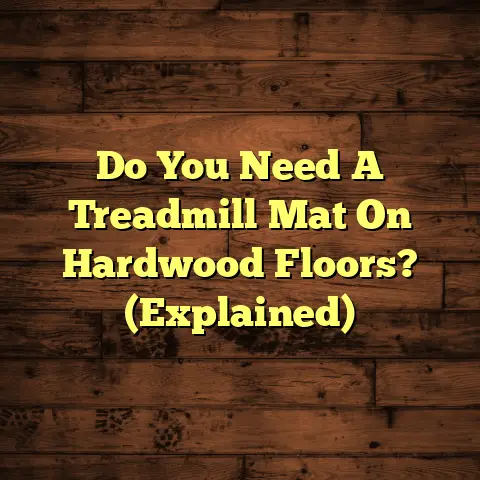Using Caulk To Fill Gaps In Floorboards? (Explained)
“Floors are the foundation of a home, and their care reflects the love we put into our spaces.” This quote resonates with me every time I step into a room, especially when dealing with gaps in floorboards. Having spent years as a flooring contractor, I’ve learned that caulking can be an invaluable tool in maintaining and enhancing the aesthetics of any flooring project. In this article, I’ll share my experiences, insights, and tips on using caulk to fill gaps in floorboards effectively.
Understanding the Importance of Filling Gaps
Gaps in floorboards can be unsightly and may even lead to further damage if not addressed. I recall a residential project where a client complained about drafts coming from the floor. Upon inspection, I found significant gaps between the planks. Not only did these gaps cause discomfort, but they also led to increased energy bills. Addressing these gaps promptly not only improved the home’s comfort but also made the space look polished.
When I first started my career in flooring, I underestimated the impact of gaps. I thought they were just cosmetic issues, but over time, I realized they could lead to more significant problems, including:
- Increased Energy Costs: Gaps can allow air to escape, making it harder for heating and cooling systems to maintain a consistent temperature. A client once mentioned that after sealing the gaps, their energy bills dropped by 15%. That’s a substantial saving!
- Moisture Damage: Gaps can allow moisture to seep in, leading to potential mold growth or damage to the subfloor. On one occasion, I encountered a situation where untreated gaps resulted in water damage that required expensive repairs.
- Pest Invasion: Small critters love to find their way through gaps in floors. I’ve had clients express concern about bugs and rodents entering their homes through these openings. Sealing gaps can prevent these unwanted guests.
- Aesthetic Appeal: A well-maintained floor enhances the overall appearance of a home. After filling gaps, I often hear clients comment on how much more inviting their space feels.
Choosing the Right Caulk
Not all caulks are created equal. When selecting a caulk for filling gaps in floorboards, I consider several factors:
- Material Compatibility: Different flooring materials require specific types of caulk. For instance, latex caulk works well with wood floors, while silicone is better suited for tile or vinyl. I once made the mistake of using silicone on hardwood flooring, which created a messy situation that was difficult to clean.
- Flexibility and Durability: The caulk should be flexible enough to accommodate the natural expansion and contraction of flooring materials. I’ve had success with acrylic latex caulk that includes silicone for added flexibility. This combination helps ensure that the caulk remains intact over time.
- Color Match: Aesthetics matter! The caulk should blend seamlessly with the floor color. I often bring caulk samples to the job site so clients can choose the best match. Once, I had a client who was very particular about color matching; we spent extra time selecting the perfect shade, but it was worth it when they saw how well it blended.
- Ease of Cleanup: Some caulks can be messy to work with. I prefer products that clean up easily with water while still wet. This saves me time and ensures a neater finish.
Preparing for Application
Preparation is key to achieving a clean finish. Here’s how I usually prepare:
- Clean the Area: I start by vacuuming the floorboards to remove dust and debris. A clean surface ensures better adhesion. Sometimes I use a damp cloth to wipe down surfaces, especially if there’s any sticky residue from previous repairs.
- Measure Gaps: Using a gap gauge or simply my fingers, I measure the size of the gaps. This helps me determine how much caulk I’ll need and whether I should select a specific type based on size.
- Choose the Right Tools: A caulking gun is essential for applying caulk smoothly. I also keep a damp cloth handy for quick clean-up and a putty knife for spreading. Having the right tools on hand makes the process much smoother.
- Assess Environmental Conditions: Temperature and humidity can affect how well caulk adheres and cures. If it’s too cold or too humid, I may choose to postpone the job or adjust my approach accordingly.
Application Process
Applying caulk effectively requires some technique:
- Cut the Nozzle: I cut the tip of the caulk tube at a 45-degree angle for better control. This angle allows me to create a bead that fits snugly into the gap.
- Apply Caulk: Starting at one end of the gap, I apply a steady bead of caulk, ensuring it fills the space completely. It’s important to move steadily to avoid lumps or uneven application.
- Smooth It Out: After applying, I use my finger or a putty knife dipped in water to smooth out the caulk. This gives it a professional finish and removes any excess. A tip I’ve found helpful is to keep my finger slightly wet while smoothing; it prevents the caulk from sticking too much.
- Let It Cure: Most caulks need time to cure before exposing them to foot traffic. I usually advise clients to wait at least 24 hours, but it can vary based on the product used and environmental conditions.
- Inspect After Curing: Once cured, I return to inspect my work. If there are any areas that didn’t fill properly or if cracks reappeared, I’ll apply additional caulk as needed.
Real-Life Experiences
I remember working on an older home with original hardwood floors that had seen better days. The gaps were not just aesthetic; they were also allowing moisture to seep in, causing potential damage. After filling those gaps with high-quality acrylic-latex caulk, we noticed an immediate improvement in the room’s warmth and overall appearance.
However, challenges do arise. In another project, applying caulk in high humidity led to longer curing times and some bubbling in areas. This taught me to check weather conditions before starting such tasks.
One memorable job involved restoring a historic building where the original wood floors were beautiful yet incredibly worn down. The gaps were extensive due to years of settling and wear. My team and I decided to fill these gaps with caulk mixed with wood filler to achieve a more seamless look. It took extra time and effort but resulted in stunning floors that maintained their historical charm while being functional.
Cost Estimation and Planning
Accurate cost estimation is crucial in any flooring project. I often rely on FloorTally for this purpose. The platform allows me to input all necessary data related to materials and labor costs, providing a realistic budget estimate that includes caulking expenses.
For instance, I recently worked on a 1,500-square-foot project where we filled gaps across various rooms. The estimates generated by FloorTally helped me communicate effectively with my client about potential costs—sealing gaps added approximately $200 to the overall budget, which was well worth it for the improved comfort and aesthetics.
Having real-time access to local material prices through FloorTally also helps me stay competitive in my pricing while ensuring quality work for my clients.
Maintenance Tips
Filling gaps is not just a one-time task; it requires ongoing maintenance:
- Regular Inspections: I recommend checking for new gaps regularly, especially during seasonal changes when wood expands and contracts. If you notice any new openings forming, address them promptly before they worsen.
- Reapplication: If you notice cracks or wear in the caulk over time, reapply it as needed to maintain effectiveness. In one case, I had filled gaps in a home where pets frequently roamed; after a couple of years, we needed to touch up some areas due to wear.
- Avoid Excess Moisture: Keeping indoor humidity levels stable can prevent future gaps from forming. Using dehumidifiers during particularly humid months has been beneficial for many clients I’ve worked with.
- Educate Clients: When working with clients, I take time to explain how important it is to maintain their floors and what signs they should look for that might indicate new gaps forming or other issues.
Alternative Solutions
While caulking is effective, there are alternatives worth considering:
- Wood Strips: For larger gaps, installing wood strips or quarter round can provide a more structured solution and enhance appearance. In one project where we had significant gaps due to settling floors, we opted for custom wood strips that matched perfectly with the existing flooring.
- Flooring Expansion Joints: In larger spaces, incorporating expansion joints may be necessary to accommodate natural movement without compromising integrity.
- Flooring Replacement: In cases where floors are beyond repair or have significant damage, replacing sections or even entire floors may be more practical than attempting repairs.
Comparing Caulk Brands
Over my years working with various types of caulks, I’ve tried several brands and products. Here’s how some of them compare based on my experiences:
- Dap Alex Plus: This acrylic-latex caulk is my go-to for most wood floors because it’s easy to apply and paintable once cured. It provides good flexibility and durability but may require reapplication every few years depending on wear.
- Gorilla Clear Grip Caulk: Known for its strong adhesion and waterproof properties, this silicone-based caulk is excellent for areas prone to moisture but can be challenging to clean up if you’re not careful during application.
- DAP 230 Premium Window, Door & Trim Sealant: While designed primarily for windows and doors, I’ve used this on floor gaps as well due to its exceptional flexibility and paintability.
- Loctite PL Premium Polyurethane Construction Adhesive: This heavy-duty adhesive works wonders on larger gaps but requires more prep work since it’s a bit messier during application.
Each product has its strengths and ideal applications; understanding these differences helps me choose wisely based on each project’s specific needs.
Floor Types and Their Unique Requirements
Different flooring types present unique challenges when it comes to filling gaps:
- Hardwood Floors: These floors expand and contract significantly with temperature changes. Filling gaps here often requires flexible caulks designed for wood applications.
- Laminate Flooring: With laminate flooring not being as porous as wood, it can be easier to fill gaps with standard acrylic latex caulks without worrying about moisture issues as much.
- Tile Floors: Grout lines often take precedence over gap-filling in tile installations; however, using silicone around edges can help seal any small openings effectively.
- Vinyl Flooring: Vinyl can sometimes warp if heat is applied during installation or repairs; therefore, using a flexible silicone-based caulk that will allow movement without cracking is key.
Addressing Client Concerns
When working with clients on filling gaps in their floors, I’ve learned that communication is crucial:
- Setting Expectations: Before starting any work, I explain what they can expect regarding aesthetics and durability post-repair so there aren’t any surprises later on down the line.
- Post-Application Care: After applying caulk and allowing it time to cure properly, I advise clients about foot traffic restrictions until everything has fully set up—which helps eliminate any mishaps early on!
- Follow-up Visits: Maintaining contact after completing work allows me an opportunity for follow-ups down the road if needed while demonstrating my commitment towards quality service—even long after our initial engagement has finished!
Final Thoughts
Filling gaps in floorboards with caulk can significantly improve both comfort and aesthetics in any space when done correctly! While challenges may arise along this journey—from choosing appropriate products through application techniques—proper preparation combined with experience will lead toward successful outcomes every time!
So next time you notice those pesky gaps forming beneath your feet—consider reaching for some good quality sealant instead! Trust me; your floors will thank you!





